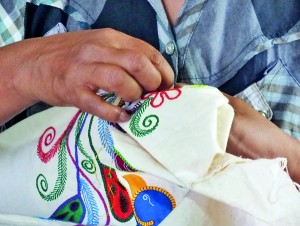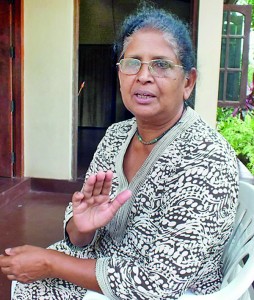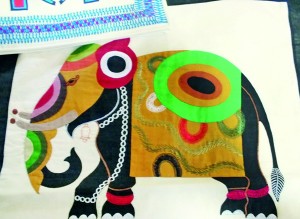Delicate art of Needle-craft in the hills of Kandy
The history of this country and the ancient monuments that are left behind or which now remains shows that the craftsmanship, art, sculpture, stone carving, architecture, pottery, designing and many other such activities had been glorious during the time of ancient kings in Sri Lanka. This is evident even during the medieval times and the period of the Kandyan Kingdom and subsequent foreign invasions.

Sewing in progress.
The evidence of such, skilled craftsmanship is still present in Kandy, Polonnaruwa, Anuradhapura, Sigiriya and many other places in the country.
Last week a team from the Business Times was in Naththarampotha village, about six km off Kandy on the Kandy-Digana road where brass craftsmanship has gone from generation to generation.
During the late Sirimavo Bandaranaike’ tenure as Prime Minister in the 1970s, 36 families in this area were given free land as an inducement to promote making brassware. During the same period another 36 blocks of land were awarded for the same purpose.
The craftsmanship, prowess and great talents in needle-craft, which throughout won multitude of accolades saw Ms Manel Madawala receive a land in Naththarampotha during President Ranasinghe Premadasa era when he awarded land to another 36 families.
The story of success of Ms Madalawa is one of sheer craftsmanship, talent, courage and endurance where she has stunned the world with her dexterity with the small needle. Vivid coloured threads etched on pieces of cloth have been transformed to great home décor that have gone to many foreign lands.
She started her career as a dancer specialising in Kandyan and Kathakali and her in-born talents helped her to become a dancing instructor in the National Dancing ensemble in the early 1970s.

Ms Manel Madawala explains her rise to fame as a successful entrepreneur using skills of her hands and a small needle.
During that time she was also involved in designing and stitching all the costumes needed for all the dancers in ensemble. In 1975 when she realised her husband’s business was failing, Ms Madawala instantly decided to change her career to needle-craft.
Renting a house at Kadugannawa facing the main Colombo-Kandy road, her youthfulness mixed with creativity led her to produce some creative work that drew the attention of foreign tourists, buying her items as souvenirs.
As the foreign clientele turned into bus loads, she employed more than 50 young women to attend to ancillary work, she told the Business Times at her factory cum home in Naththarampotha.
Her craftsmanship has become very popular resulting in her participation in exhibitions and competitions in handicraft, winning awards. This attracted the attention of the National Design Centre and being awarded a piece of land in Naththarampotha.
Ms Madawala says her turning point to be a creative needle-craft specialist is her inborn talents. At her home in a cliff seated on the verandah, enjoying a cup of tea she told the Business Times that she built her decent but luxurious home, all by herself with the money she earned by selling her creative crafts.
Among her needlecraft are bedspreads, pillow covers, wall hangings, bags, etc. Another specialty in her craft is the originality of Sinhala needle-craft –like Bulath-Malla, decorative costumes of ancient Nilames which are based on Sinhala needlecraft. Her earlier works have been making flags depicting ancient Sri Lankan designs, matching the exact, original colour combination. Throughout her needlecraft career, she has never deviated from the original Sinhala design or their colours.
At a distance her needlecraft work looks like meticulously drawn paintings, but only at a closer look they emerge as needle work.
Though she had maintained the same magnitude of business after moving to Naththarampotha in 1993, she lost the business of tourists buying directly from her and is now selling to middle-traders and other exporters.

Completed products.
Ms Madawala said they sell to mega stores like Lakpahana, Lakmedura, Laksala, etc. There is a steady demand and she said they also do (some) direct exports to Canada.
The volume of sales is around 500 pieces of different varieties per month. She is now progressively training her daughter Ms Vajira de Silva. Needle-craft is difficult to learn, time consuming and thus there is the difficulty in attracting girls to engage in this craft as they could make quicker money in garment factories. Ms Madawala said that at present she has turned it into a cottage industry and more than 10 girls are engaged in the trade as a cottage industry. She said that as a sideline these girls earn more than Rs 8,000 per month.
She said that if she could employ more girls and with some training they could increase their volume of products as the demand is there.
In 2002 she was the Vice President of the National Chamber of Handicraft of Sri Lanka and continued to be so until 2008. From 2008 to 2011 she was the president of this chamber. While she and her daughter attends to the needlecraft business, she is also devoting some of her time to work for the development of handicrafts in the country and is also taking handicrafts persons on exposure tours in the country and abroad.
Ms Madawala said that they also got the help of various countries to have them trained in leadership and said that they have got teachers of handicraft from Germany.
Follow @timesonlinelk
comments powered by Disqus


